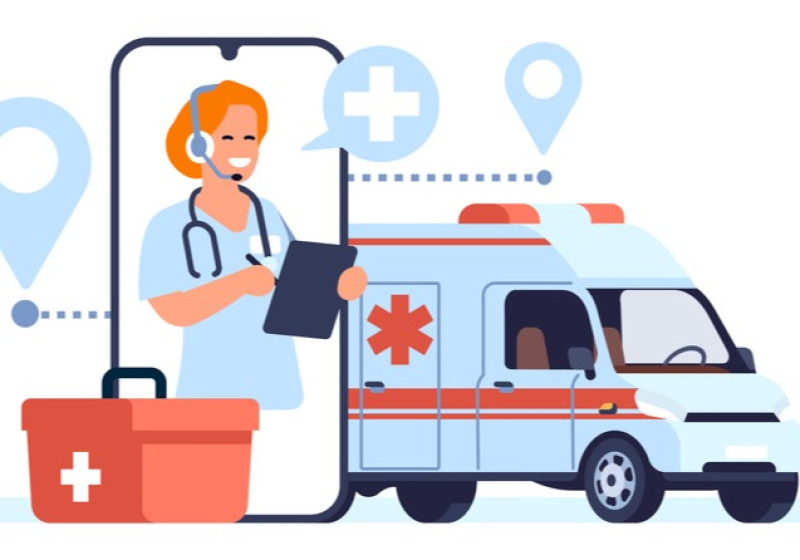
Sometimes, in EMS, we get in a bit over our heads. It’s important to get comfortable calling for additional resources or a higher level of care to ensure our patients receive the best possible care, but calling for help can be difficult. Calling for help too early or too often can waste resources, but not calling might mean missed opportunities for essential prehospital care. Here are some suggestions for deciding when to call for help:
BLS Calling ALS
In many places, BLS providers serve in a first-response role, and in a tiered system, BLS providers might handle some calls independently. EMTs can temporize critical patients and begin life-saving care, but some patients will still benefit from ALS care. As you gain experience as an EMT, you’ll develop a good sense of “sick vs. not sick” patients, so call for ALS when your gut tells you “they’re really sick!” In the meantime, there are some more tangible signs that you can look for. For example, looking at skin signs is typically a good place to start: pink, warm, and dry skin is usually a good sign, while pale, diaphoretic, or cool-to-the-touch skin is more ominous. Other vital signs out of the normal range might also be concerning, especially if they aren’t easily explained. For example, a low SpO2 reading might still be within your capabilities if it can be easily remedied by placing a nasal cannula, or a high heart rate might be explained by recent exertion or pain. If you’re concerned that the patient might be having a stroke or heart attack, is septic, or meets trauma system entry criteria, things can get a bit more complicated. On the one hand, ALS interventions for these patients can make a real difference for the patient, but it’s also worth considering that what these patients need most is definitive care. A huge part of our job in EMS is actually logistics more than medicine, so you’ll need to know the system you’re working in well enough to decide whether to wait for ALS or get the patient to the hospital. For example, if the nearest ALS provider is coming from the hospital you’d be transporting to, and you can transport the patient, you could have the patient to definitive care just as quickly as ALS could reach them, so don’t wait for ALS in this case. Most of the ALS care for these patients is supportive, so if only seconds or a handful of minutes are saved, it is not likely worth sacrificing time waiting for ALS to arrive.1
ALS Calling Medical Control
Sometimes, standard ALS isn’t enough to handle every situation. For example, you may not have a protocol to cover a specific disease process or patient condition. A common one I run into in my practice is the need to call medical control regarding the use of Versed (midazolam) for patients with acute alcohol withdrawal symptoms or carpal/pedal spasms.
Another time that ALS might need to call for orders is when the patient just isn’t fitting in any of your boxes. For example, CHF/flash pulmonary edema patients with low blood pressure rather than the typical hypertension can be incredibly difficult to manage, so consulting with a physician might yield good advice.
A third example of a good time to call medical control is for grey-area problems. For example, if you’re reading an ECG that objectively shows ST-elevation in contiguous leads but also shows several signs of left ventricular hypertrophy in an otherwise healthy young patient without chest pain, you could call medical control to consult on whether they want you to activate a STEMI alert anyway. Conversely, a patient may have a pacemaker or left bundle branch block, and you might notice their ECG meets Sgarbossa criteria even if your agency does not use those criteria to identify STEMIs, so you could call medical control and make your case for activating a STEMI alert anyway. The important thing to remember when calling medical control is that at the end of your conversation, whether you got the order you were asking for or not, you are bound by the direction of the physician to whom you spoke.
ALS “Pit Stop” at the ER
In systems with multiple hospitals to which an ambulance could transport, triaging and selecting the appropriate transport destination is a vital role of EMS. For example, bringing trauma patients to trauma centers and C-STAT-positive strokes to ELVO-capable centers is vital to ensuring that our patients get the best care available. Sometimes, this will mean driving a little bit farther, or even right past a less-capable hospital, to get to the most capable center for the patient’s condition. In very rare circumstances, it might be appropriate to “pit stop” at the nearest emergency room for immediate intervention in some patients before carrying on to a more appropriate destination. Still, this choice must be made very carefully. For the most part, the only time it’s appropriate to stop is for help with an ABC issue. Any ER is likely equipped with difficult airway tools to help solve airway problems, and any ER should be able to handle a cardiac arrest (at least until ROSC). If your patient needs airway management that you can’t provide or arrests during transport, it is likely worth the delays caused by stopping at the closest hospital. EMTALA laws require that once a patient arrives at an emergency room, they must be evaluated and stabilized within the hospital's capabilities before they can be transferred to another hospital, which can make a “quick stop” tricky to navigate. Still, advocate for your patient and be ready to resume transport as soon as the issue is handled.
Ground Calling Flight
Sometimes, we may need to decide between an air or ground ambulance to transport patients. Patients with especially time-sensitive conditions like major traumatic injuries, STEMIs, strokes, and burns might benefit from the time savings of an air ambulance, but figuring out exactly what the breaking point is can be tricky. One study showed that if the patient is more than 21.7 miles (35 km) from the appropriate hospital, an air ambulance will likely result in faster definitive care.2 Another rule of thumb is that if you think the air ambulance is likely to save more than 20-30 minutes, call for them. This rule of thumb is based on the logistical complexities that often present when calling a helicopter to the scene. Between spool-up time (usually 8 minutes or less) and scene time (usually 10 minutes or less), this leaves a few minutes to spare for transporting the patient to a suitable landing site (as often, the helicopter cannot land right at the scene) or weather delays.
Other appropriate times to call for an air ambulance include multi-patient scenes or mass casualty incidents when the sheer number of patients outnumbers the capacity of ground ambulances or for special procedures and tools like advanced airway management, blood products, or escharotomy. It could also be that the patient requires treatments that local hospitals cannot provide. For example, many critical access hospitals throughout the country do not have a catheterization laboratory to provide definitive care for a STEMI, so flight may be a good option to get the patient to the care they need faster (refer to the time and mileage guidelines discussed above to help you decide).
- 1. Drenck, N., Viereck, S., Bækgaard, J. S., Christensen, K. B., Lippert, F., & Folke, F. (2019). Pre-hospital management of acute stroke patients eligible for thrombolysis – an evaluation of ambulance on-scene time. Scandinavian Journal of Trauma, Resuscitation and Emergency Medicine, 27, 3. https://doi.org/10.1186/s13049-018-0580-4 https://doi.org/10.1186/s13049-018-0580-4
- 2. Stowell, A., Bobbia, X., Cheret, J., Genre Grandpierre, R., Moreau, A., Pommet, S., Lefrant, J.-Y., de La Coussaye, J. E., Markarian, T., & Claret, P.-G. (2019). Out-of-hospital Times Using Helicopters Versus Ground Services for Emergency Patients. Air Medical Journal, 38(2), 100–105. https://doi.org/10.1016/j.amj.2018.11.017 https://doi.org/10.1016/j.amj.2018.11.017
- 3. 3) Steenhoff, T. C., Siddiqui, D. I., & Zohn, S. F. (2023). EMS Air Medical Transport. In StatPearls. StatPearls Publishing. http://www.ncbi.nlm.nih.gov/books/NBK482358/ http://www.ncbi.nlm.nih.gov/books/NBK482358/
- Dozens of courses and topics
- State-specific requirements
- We report to CAPCE in real time


